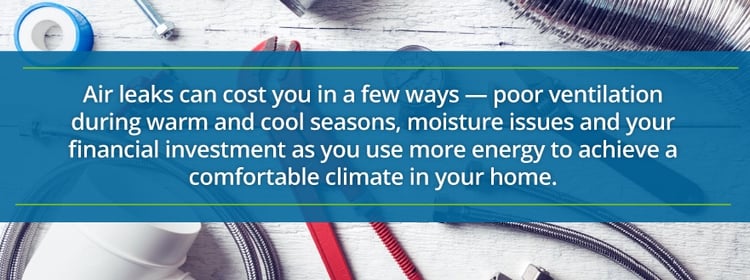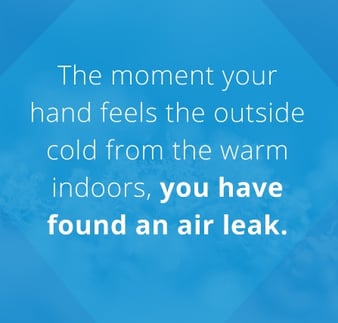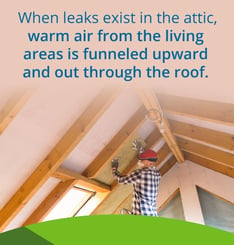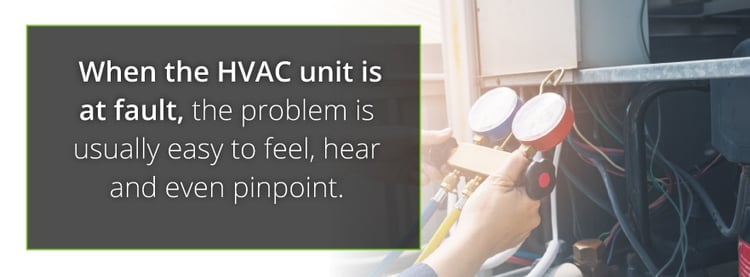
Detecting air leaks can be an easy or difficult process, depending on where the leak is located. The signs of warm air leaking from your house are sometimes physically felt, but they often go unnoticed as you crank your heat up higher and higher. Therefore, knowing how to inspect for air leakage is important for your personal comfort, as well as for the energy efficiency of your house.
Of course, locating air leaks is not something you can do with the naked eye. Whether you are looking for slight gaps along the edges of doors and windows or hoping to discover the root of HVAC air leaks, the task will generally involve testing tools.
How Much Do Air Leaks Cost?
During the cold autumn and winter months, the insulation of inside warmth is crucial for the comfort of your household. Heating costs throughout fall and winter are high enough without the additional expense of air leaks.

Unfortunately, air leaks can cost you in a few ways — poor ventilation during warm and cool seasons, moisture issues and your financial investment as you use more energy to achieve a comfortable climate in your home. That means it’s worthwhile to ensure your home is leak-free.
How to Find an Air Leak
In a residential property, air leaks typically stem from cracks along the doorways and window frames. Though these leaks are sometimes hard to notice, you will gradually face diminished comfort and rising monthly bills or potentially feel the air coming in or out. Sooner or later, the problem becomes too big to ignore any longer.
Air leaks can be especially costly if you live in a larger house, where leaks could be present in dozens of places. Leakage also typically stems from hair-thin cracks throughout the basement, attic and living areas.
While it is often hard to locate the source of an air leak, the task can ultimately be accomplished with some basic tests. You will need to run these tests in each room, as well as in the attic and basement or crawlspace. Better yet, hire a contractor to run some tests for you, as a contractor will have the most advanced tools for the task.
Test for Air Leaks With Your Hand

During the colder months of the year, when the heaters are running inside your home, it is relatively easy to feel the difference when you manage to locate a tiny draft of outside air. Hold your hand over the following typical leak spots to feel for possible coldness:
- Exterior doors. If the cold outside air can be felt along the edges of your living room door or backdoor, the seal between the door and frames is not tight enough.
- Windows. If a draft of coldness is noticeable around the windows, a slight gap has probably formed somewhere between the glass panes and window frames.
- Air vents. If the vents won't shut properly, cold outside air can leak into your home.
- Fans. As with faulty vents, fan systems can be a source of insulation leakage.
The moment your hand feels the outside cold from the warm indoors, you have found an air leak. In some cases, an air leak will form around an electrical outlet. The hand test is generally the easiest DIY method for locating an air leak inside of a home. However, people who are inexperienced with this method will sometimes mistake cold surfaces — such as a cold window or door edge — for faint air leaks.
Test for Air Leaks With a Candle
With a lit candle in hand, walk around to the various spots in your home where air leaks are likely to form, such as around the exterior doors, windows, light fixtures and outlets. You can also perform this test along the vents and fans, as long as you turn them off before you proceed.
Hold the candle in front of the seals and watch the flame. Does the flame become wobbly? If it does, there's a faint draft of air coming through from the outside. The candle test is generally a more accurate method than the hand test when it comes to detecting air leaks.
Test for Air Leaks With Incense
Incense is most effective for testing air leaks on cold and windy days. This test is similar to the candle experiment, except you will need to depressurize your house for this to work. Before you get started, turn off the HVAC system, as well as any fans in your kitchen and bathroom. For this test to yield accurate results, you cannot have any artificial wind currents blowing throughout your house while the test is in progress.
Light a stick of incense and walk around to all of the same spots in your house that you would test with your hand or a lit candle. If the upward billow of smoke from the incense tip suddenly blows horizontally in one direction or another, or it’s sucked toward a window or door, you've found your air leak.
Test for Air Leaks With a Leak Detector
If you are willing to spend some money to test for air leaks, purchase a leak detector — a small, handheld device featuring a light that changes color when a leak has been detected. This test can be performed on cold and hot days alike. If your house has been less and less capable of holding cool air in the summer months, a detector could help you pinpoint the reason why your A/C usage has risen since the prior summer.
With the device in hand, walk around to each of the interior spots where a leak might exist, and run the detector along the frames and vents. If the white detector light turns blue, a cold-air leak has been detected. If the light turns red, a hot-air leak has been found. If the light remains white, no leak is present.
Test for Air Leaks With a Blower Door Fan
For a more advanced means of testing — not a DIY method, but one to be performed by a contractor — consider the blower-door method. The test is performed with a large fan, which the contractor will place in front of your closed living room door. The intention here is to exploit any possible gaps or cracks that might exist. The super fan is meant to serve as an artificial wind generator that can be felt from any spot on the inside of the house where the faintest leak is present.
As the outside fan runs, the contractor will walk through your house to the likeliest vulnerable spots — windows, vents, exterior doors, etc. — to see if air is seeping through. A contractor can also test various other household features that wouldn't be applicable to DIY leak tests, such as telephone lines, cable lines and electrical/gas devices.

How Air Leaks Travel Upward in a House
Air leaks have a chimney-like effect on the insulation of houses. When leaks exist in the attic, warm air from the living areas is funneled upward and out through the roof.
As this upward suction occurs, cold air that enters the house through leaks in the basement is funneled through the ground floor into the living quarters. This chimney effect creates a cycle of energy drainage that can gradually increase your electrical bills.
How Air Leaks Form in Basements
One of the most vulnerable parts of a home to an air leak is the basement. When an air leak does form, it will usually be found along the seam between the basement wall and ceiling. The problem here is often due to unfinished sealant work along these parts. Since basements are often left unoccupied, home builders of the past would sometimes skip certain finishing details in this part of the house.
Another cause of basement air leaks are cracks through the inner cavities of the rim joist, which frames the parameter of the foundation. Since the upper portion of the basement is above ground, numerous opportunities are present for cracks to form by means of harsh weather, termites, water buildup and other external elements.
How to Seal Air Leaks at the Rim Joists
Cracks along the rim joists are generally hard to spot, but they are one of the more problematic parts of a home when it comes to air leaks. Therefore, to prevent the chimney effect at the root, seal the joist cavities along the top and bottom. Use caulk as a sealant for cracks of 1/4" or less, and spray foam for larger gaps.
As you seal up gaps in the basement, fill any penetrations that cut between the basement ceiling and ground floor. This would include the outer circumference of wiring holes, drain pipes and furnace funnels, which are typically responsible for the chimney effect that carries cold air from the basement on up through the house and out the attic.
Where to Find Air Leaks in the Attic
Air leaks are a common occurrence in attics, where the leaks are often larger and easier to spot than in other parts of the house. While smaller leaks will often be present, the larger leaks are more draining on the insulation, and, therefore, warrant greater concern. Attic leaks are typically found in the following areas:
- Bottom wall seams. The edges where the ceiling roof and floor meet are typical spots for air leaks.
- Dropped soffits. The dropped-ceiling portions could easily be cracked along the surfaces or seams.
- Kneewalls. Air will often make its way from behind or underneath the kneewalls.
A tell-tale sign of air leakage is dirty insulation, especially in the dropped soffits. If the problem is along the soffits, you will need to remove the insulation, caulk the seams, plug the cavities, cover the soffits and re-apply the insulation.
An attic will usually contain open cavities along the floor frame, under the kneewalls. Even if your attic was built with a finished room, the open cavity could easily be vulnerable to air leaks. Once again, soiled insulation will generally serve as a dead giveaway that problems are afoot. To solve the issue, you will need to strip away the insulation, plug the cavities and re-apply the insulation.
Granted, the preceding steps are often complicated and are best left to a professional unless you have experience with advanced home improvement work.
How to Tell If Your HVAC System Has an Air Leak

In a lot of air leak cases, the problem will stem from the heating and cooling system. When the HVAC unit is at fault, the problem is usually easy to feel, hear and even pinpoint. When air leaks form in an HVAC system, they are most likely to be found in the following areas:
- The cover panels. If the panels are improperly fitted or missing fasteners, this could be the problem area.
- The pipe entrance. Leaks will often form at the point where the A/C pipe enters the house, especially if the grommets are in poor shape.
- The insertion point. The base of the air filter could possibly leak air.
An HVAC air leak could also be the result of a faulty installation. If the installers didn't secure the unit and seal gaps effectively when the HVAC was first set up, your house has possibly been subject to an energy drain from the start.
How to Fix an HVAC Air Leak
If your HVAC unit has an air leak, the following steps can help you put a stop to the problem, as long as the leaks are not too advanced or spread across the system as a whole:
- Secure the panels. Check for loose fasteners on the panels and tighten any that need fastening.
- Straighten the panels. If any of the panels are bent, try to straighten them out. Recheck the seals to ensure the panels are tightly fastened.
- Plug the leaks. If you can pinpoint gaps that leak air along the system, cover them with mastic or perma-gum.
- Secure the insulation. Check the insulation to ensure it packs tightly into place behind the panels.
Of course, the most surefire way to rectify an HVAC air leak is to call a professional and have the unit inspected and fixed. Still, DIY repairs will often work on minor HVAC leaks. If you have experience with performing maintenance on household appliances and machines, the preceding steps could help you save money.
Buy Heating Oil Online at Smart Touch Energy
During the winter months, the conservation of heat is of utmost importance to homeowners across most of the U.S., especially in the northern states. With so much outside coldness to beat, it is crucial to have the most powerful and efficient means to heat your home. If your house uses an oil heater, the go-to supplier for heating oil is Smart Touch Energy.
At Smart Touch Energy, we sell heating oil here from our website to homeowners throughout much of the Northeast. With customers in Connecticut, Delaware, Maine, Massachusetts, New Hampshire, New Jersey, New York and Rhode Island — as well as parts of Maryland and Pennsylvania — we are the number one name in heating oil.
Our prices are below the EIA average by as much as $0.40, and this gives our customers more for their money. To learn about our products and services, visit our services pages.



